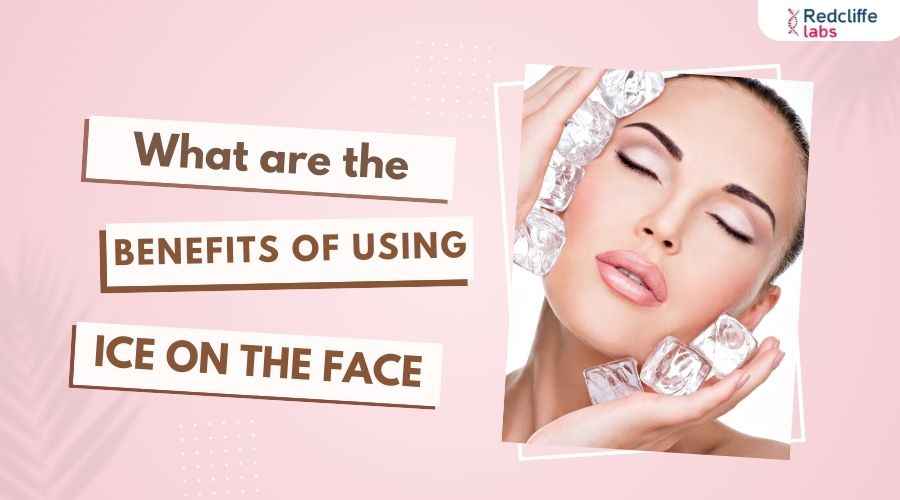What are the Benefits of Using Ice on the Face?

Medically Reviewed By
Dr. Geetanjali Gupta
Written By Kirti Saxena
on Oct 16, 2024
Last Edit Made By Kirti Saxena
on Jul 19, 2025

Icing your face is popular these days. Well, this is not just to reduce black eyes or bumps on your forehead; it is more than that.
This is the way to refresh your skin. This easy skincare has gained popularity because it instantly revives dull skin, reduces puffiness, and gives your face a natural and healthy glow.
Ice helps to tighten the pores, soothe inflammation, and improve blood circulation.
It is a go-to remedy for those looking for natural ways to improve their skin's appearance.
Moreover, this is not only convenient but also versatile. And you know the best part—it is appropriate and safe for all skin types and can easily fit into even the busiest routines.
So, if you want to minimize redness, reduce breakouts, or simply wake up your complexion, icing your facial will help you get instant results that feel as good as they look. Want to know more? Let's learn more about the benefits of icing your face, how to do it, and more.
What is facial icing?
It's simple. As the words say, facial icing is the same as applying ice to your face.
It is a technique in which you gently massage your face with ice. This will boost blood circulation and give you an instant, natural glow. It's like a mini-facial treatment you can do at home for free!
5 Benefits of Icing Your Face
Due to their multiple benefits, ice facials, or facial icing, have become a popular skincare trend. Here are some of the top benefits:
- Reduces Puffiness and Inflammation
Everyone knows about the benefits of eye-on injuries. Ice helps drain excess fluids from the lymphatic system and decreases facial puffiness. Cold therapy can also calm irritated skin and help reduce redness and inflammation.
- Minimizes the Appearance of Pores
Ice therapy can temporarily shrink the appearance of pores, provide a smoother skin texture, and make it less noticeable. This can help reduce oil pores and dirt accumulation, which may help prevent acne.
- Helps Reduce Acne and Blemishes
Ice can decrease inflammation and redness in acne-prone areas, helping blemishes appear smaller and less noticeable. It can also reduce oil production, a contributing factor to acne.
- Reduces Dark Circles
Lymphatic drainage reduces overall puffiness and the appearance of puffy under-eye areas. Gently ice under the skin will help release fluid buildup, drain toxins, and tighten the skin.
- Provides a Youthful Glow
Regular icing on your face can slow down the signs of aging and give you a more youthful appearance by enhancing your skin's elasticity. This will make you look lighter, brighter, and more radiant.
How to Use Ice on Your Face?
Using ice on the face is simple, but here are some steps you should follow for the best results-
Step 1- Cleanse Your Face First
Before applying ice, wash your face to remove dirt and oils.
Step 2- Wrap Ice in a Soft Cloth
Do not apply ice directly to your face; it might cause irritation or even ice burns. Use a soft cloth or thin towel as a barrier.
Step 3- Massage in Circular Motions
Gently massage your face with the ice-wrapped cloth in circular motions for 1-2 minutes. Focus on problem areas, such as under-eye bags, swollen cheeks, or inflamed acne spots.
Step 4- Repeat as Needed
You can repeat this procedure once a day or as recommended for your skin type.
Step 5- Apply moisture
Apply moisturizer to your skin to maintain its moisture level.
Tips for Facial Icing
Here are a few tips to make your ice facial more effective:
- Use Green Tea or Chamomile Ice Cubes- These cubes have anti-inflammatory and calming properties, perfect for soothing irritated skin.
- Consider aloe vera ice cubes. Aloe vera hydrates and refreshes your skin, so icing your face with it is good for your facial icing routine.
- Ice cubes with rose water- Freeze rose water and gently massage ice on your face to reduce inflammation and redness.
- Ice cubes with cucumber—Blend the cucumber and strain it. Now, freeze the cucumber juice and apply it to your skin to benefit from its cooling and moisturizing properties. It will calm your skin and also reduce puffiness.
- Use regularly—To get the maximum benefits and improve your skin, try adding it to your skincare routine.
- Be gentle. Use a soft cotton cloth to cover the ice. Do not directly apply the ice to your face. Always use mild pressure to ice your face.
Why Are Ice Facials So Popular?
Ice facials have gained popularity due to the following reasons-
- Affordable- Ice facials are cost-effective compared to high-end spa treatments. All you need is ice cubes, which are readily available at home.
- Natural Skincare Solution: To make it more effective, Add cucumber, green tea, and rose water. Icing your face is a natural way to improve skin tone, reduce puffiness, and achieve a radiant glow.
- Instant Results- Ice facials provide instant skin tightening and a fresh, rejuvenated appearance, making them an attractive choice for those seeking immediate results.
What are the Side Effects of Ice on Your Face?
Although there are many advantages to facing icing, it is also important to be aware of potential disadvantages as well:
- Skin Irritation—Applying ice to your face can cause skin irritation, redness, and even frostbite.
- Sensitivity- People who have sensitive skin might feel uncomfortable using face icing.
- Broken Capillaries—Excessive or forceful use of ice on the face can break capillaries and result in red lines on the skin.
- Temporary Numbness- Using ice for a long time can cause numbness on the face and make you uncomfortable.
Who Should Avoid Ice Facials?
Applying ice on your face is not that harmful or dangerous. Here are people who should avoid this treatment:
- People with Sensitive Skin- Those prone to irritation or broken capillaries should skip ice facials or consult a dermatologist.
- People with Skin or Cold Allergies- Some individuals are allergic to extreme colds and may experience hives or other allergic reactions.
The Key Takeaways
Ice facials are most versatile and work for all skin types. It can help reduce dark circles and acne and refresh your skin. Plus, with just a few minutes of daily or weekly use, you can enjoy a mini-facial treatment that rivals expensive spa visits! This is safe, but if you have specific conditions, it is a good idea to consult your doctor before trying ice facials. With its soothing and revitalizing effects, facial icing is a beauty hack that delivers fast results. So, why give it a try today?
FAQ’s
1. Is it Safe to Use Ice on Your Face?
Yes, icing your face is safe to use. But you should take preventive measures before using it. For instance, always use a soft cloth to avoid direct contact with ice. Do notice more than 1-2 minutes. If you notice any skin irritation, consult your doctor.
2. How Often Can You Use Ice Facials?
The frequency of ice facials depends on the skin type and goals. If you’re doing ice facials for long-term glow and skin tightening, 2-3 times a week is generally enough.
3. How Long Can You Ice Your Face?
Limit ice facial for 1-2 minutes per session to avoid any potential damage or discomfort.



